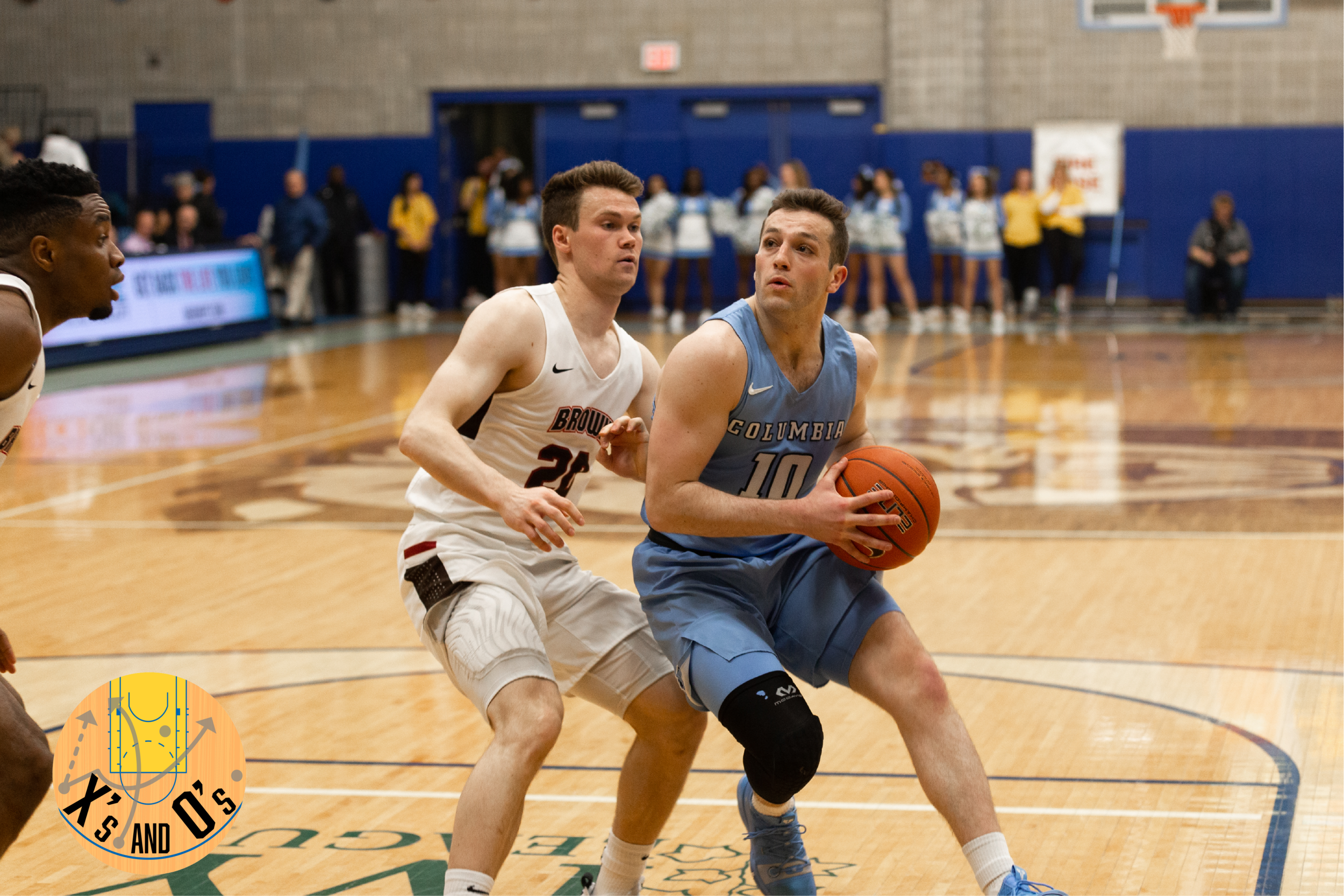X's and O's: These Lions have horns
(Logo: Chase Manze, Photo: Ben Goldsmith)
A zoologist will affirm that lions don’t have horns, but these Lions sure do.
The so-called “horns” set involves two players at the elbows or two players setting picks for the ball-handler on both sides of the on-ball defender at the top of the key. Throughout the year, especially after junior point guard Mike Smith went down with a torn meniscus, Columbia has integrated more horns plays into their offense. As this past weekend’s double road victories proved, those plays are helping guide the Lions to victory
Columbia’s primary target in horns is often a high-low feed for a layup. The play initiator passes to another player—usually a big man—at the elbow and then careens around a screen at the other elbow. Ideally, this results in an open pass to the original play initiator for a layup. If not, another ball-handler circles up top from the corner to reset and reinitiate.
There are several ways of starting a new play if the initial horns set breaks down. Columbia’s motion offense tries to create backup plans for backup plans so that ball-handlers always have a safe pass in reserve. Usually, in horns, that means one of two options. The team can either fully reset with a quick handoff or pass out of the elbow (in order to get into the new play with Stefanini handling rather than Patrick Tapé, for example) or morph into one of their pet high-post plays, with one player clearing out from the perimeter while the elbow big with the ball tries to facilitate.
Another feature of Columbia’s horns set is their elevator plays. Shooters—most often Quinton Adlesh—start at the baseline before sprinting up to curl around the elbow down-screen. The Lions love running curls and handoff plays for Adlesh to get him a quick pull-up look, and their horns set certainly incorporates those targeted plays. But Adlesh is not the only beneficiary of the look, as the elevator screen can shift into a tight pick-and-roll with the big at the elbow diving to the basket if the ball-handler penetrates.
Columbia’s personnel make their usage of horns particularly interesting. The high-post facilitator has been a staple of Jim Engles’ playbook for years. This is the first season at Columbia, however, that he hasn’t had a traditional stretch big with which to scheme, after Luke Petrasek and Lukas Meisner departed Columbia in consecutive seasons.
Tapé has slid into the high-post facilitation spot for the most part, since his height gives him the ability to see and execute more passing lanes. It’s been a season of development there for him, and he’s made progress with the ball in his hands more (as has everyone, to varying degrees, without Mike Smith). Next year, his improved facilitation will show. But he’s not a threat from long range or much of a dribble-drive option.
I’ve been high on Randy Brumant—often the player at the elbow opposite Tapé—all season. After sitting much of his freshman season behind since-transferred Myles Hanson, Brumant has flashed a lot of potential in his increasing minutes. He’s not the facilitator that Tapé is out of the high post, and his shooting from distance is a slow work in progress. When (Yes, when. Not if) he develops that range, it will unlock a whole new element to Columbia’s offense.
Adlesh’s curl and contortionist footwork in tight will be gone next year, but Stefanini may be forced to reprise that role as the team balances his deserved touches with those of Mike Smith. That will likely entail more catch-and-rolls than curls, but Stefanini—never hesitant to pull up in the midrange—has shown this season that he can do just about anything on offense.
Stefanini converted on a particularly demonstrative version of horns that Columbia ran against Yale. The Lions initially began the play with Tapé and Brumant setting side-by-side down-screens at the free throw line while Adlesh rode the elevator to the top of the key. While the play broke down a little but, the team reoriented itself in a traditional horns setup. Brumant lobbed a perfect pass to Adlesh after Tapé’s strong screen tamed the Bulldog defender, and Adlesh hit the easy layup to extend Columbia’s early lead.
That’s Columbia’s horns set at its best, and the quality that the team must reproduce to continue its impressive winning streak. The horns set is not inflexible; it’s subtly versatile, and the players Columbia utilizes in it are becoming more versatile as well. Versatility and execution win games, and Columbia has done an excellent job of developing both of those attributes in their horns plays throughout the year.
As they’ve developed over the course of the season, the Lions’ horns sets have proved all the zoologists wrong.

